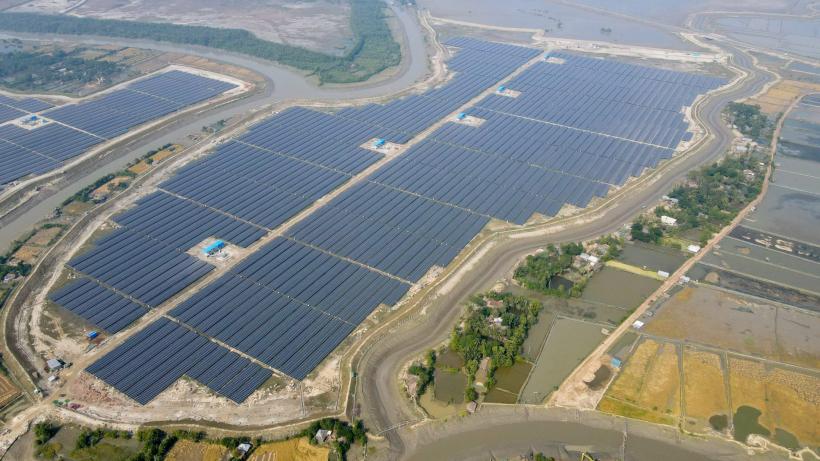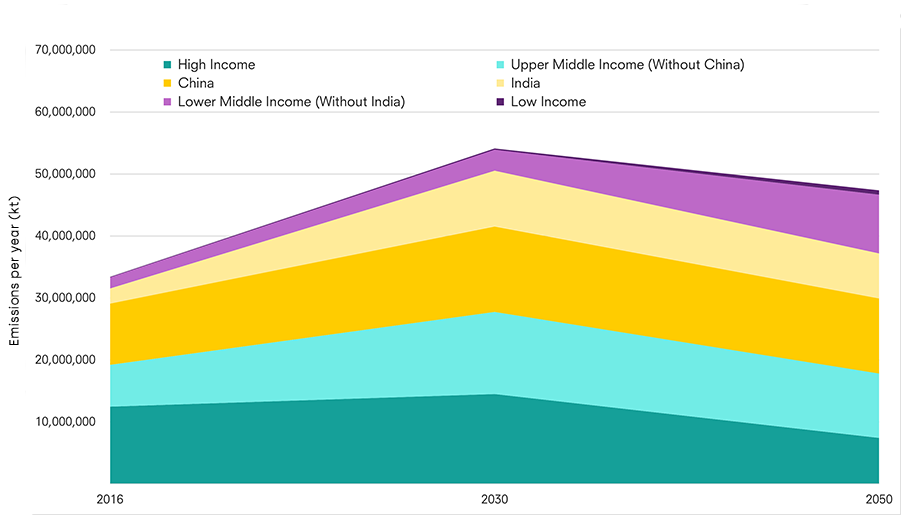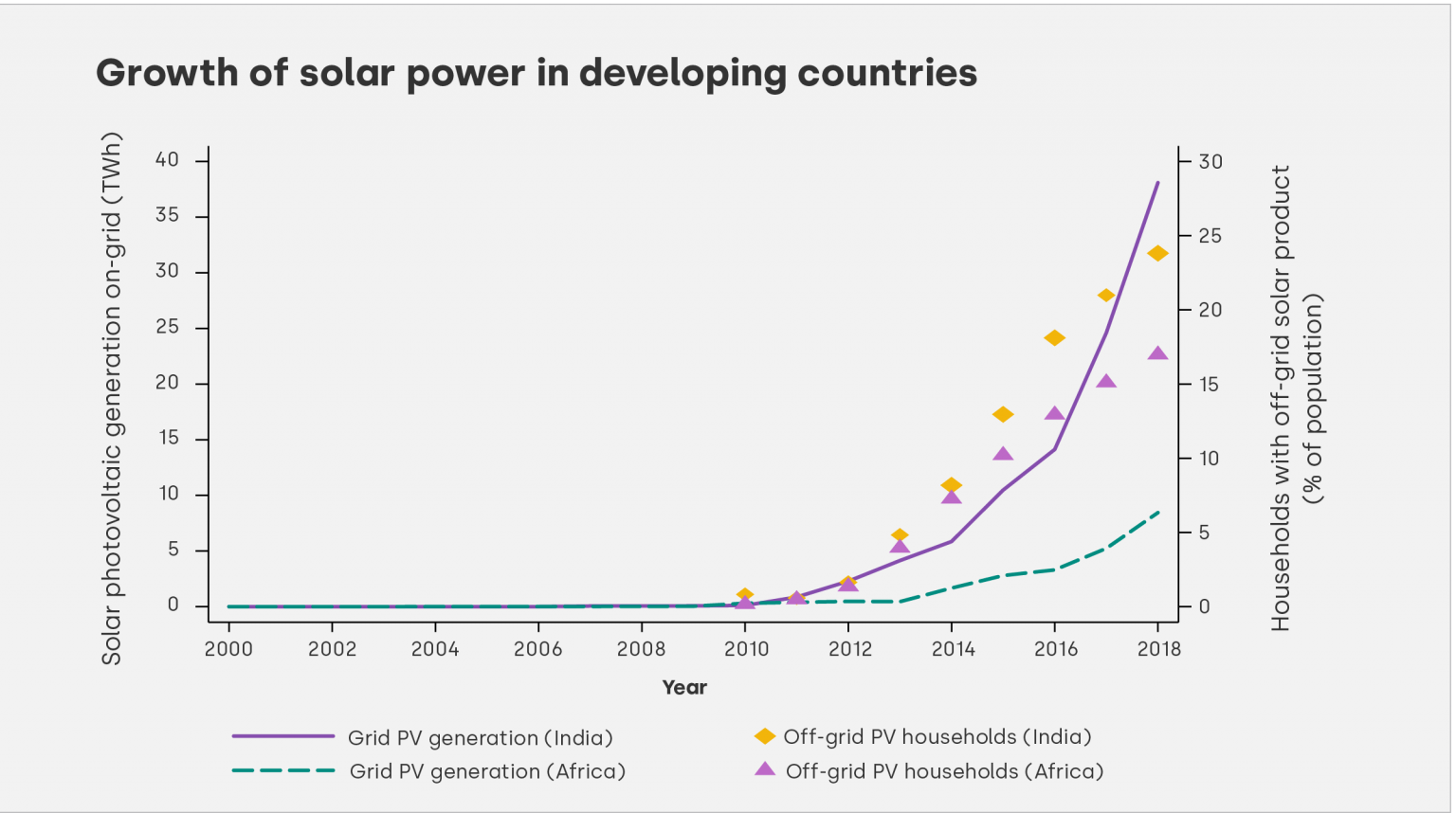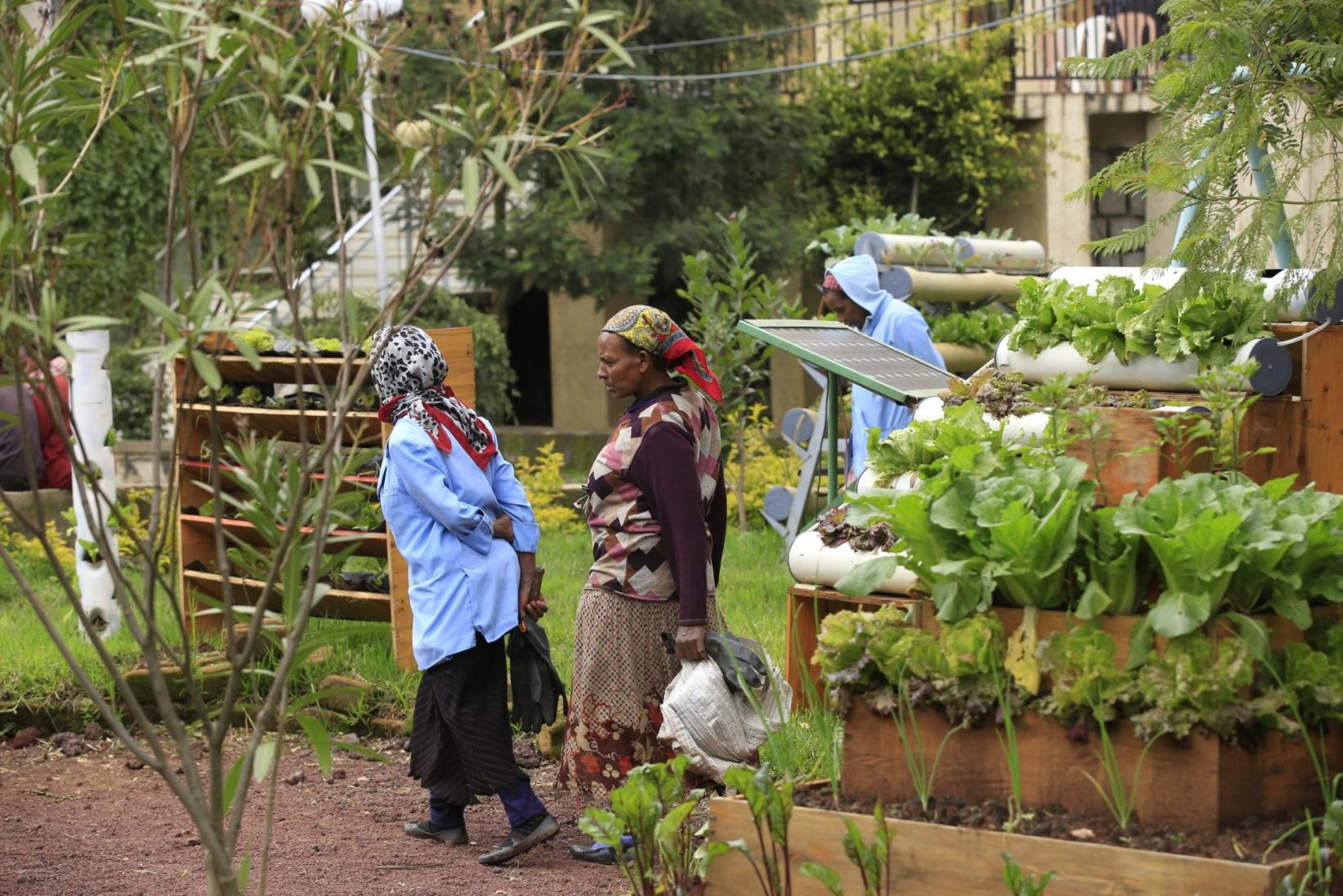
Sustainable growth for a changing climate
Climate change is the most pressing problem facing the world today. While developing countries are disproportionately affected by it, leveraging new and affordable innovations can usher them onto a greener growth path. Embedding a climate management mindset in governance and increasing job opportunities, particularly in services, are key to sustainable growth.
-
Burgess et al Growth brief September 2022
PDF document • 1.51 MB
Introduction
Future economic growth is entangled with climate change. It is clear that the once partitioned goals of development and protecting the environment must be viewed in tandem. Developing countries, which have thus far grown the least, are the most vulnerable to climate change. A conventional growth path, however, is no longer feasible as many developing countries are expected to contribute the majority of future carbon emissions. Growth must now be sustainable.
Yet this daunting challenge is not insurmountable. The advent of affordable innovations is unleashing new opportunities for developing countries to grow without generating externalities. Clean forms of electricity made possible by dramatic cost declines are eroding the global electrification divide while keeping the air free of pollutants. Infrastructure has enabled the creation of good jobs that offer higher wages while reducing exposure to the weather. New technologies dramatically prevent the crop yield decline from hot and variable weather, while the spread of markets for credit and insurance are reaching the farmers most in need. Forward-looking countries are setting policies and planning investments to manage the risks and uncertainties from climate change, such as establishing safety nets and better informing their populations of impending dangers.
Sustainable growth is therefore not a mirage but an opportunity that can be firmly grasped by today’s developing countries. While these opportunities exist, the vast array of market failures that sap development also mean success is not guaranteed. Both a well-oiled state and functioning markets will be critical to realising the promise of sustainable growth.
Key messages
- Climate change is now the most pressing, central challenge facing the world. Developing economies must aim not just to grow, but to grow sustainably.
- While developing countries are most vulnerable to climate change, they are also most likely to contribute to it in the future.
- New and increasingly affordable innovations can propel developing countries towards a greener growth path.
- Providing good jobs, especially in services, and introducing a climate management mindset hold the key to achieving sustainability.
Key message 1 – Climate change is now the most pressing, central challenge facing the world.
Energy is the source of all economic activity. Engineering revolutions across the centuries have enabled us to harness more and varied forms of energy for work, and in turn, economic growth. Around 80% of the world’s energy needs are presently fulfilled by non-renewable, fossil fuels (EESI 2021). As technologies advanced and economies expanded, fossil fuel consumption has grown nearly eight times since the 1950s (Ritchie, Roser, and Rosado 2020), and almost doubled since the 1980s. Environmental degradation has been the price of this economic growth. The devastating impact of greenhouse gas emissions has been clear for more than 100 years now (Arrhenius 1896), and yet their generation has remained unabated. This has now brought the world economy to a threshold where the damage to the environment will be irreversible if greenhouse gas emissions aren’t drastically reduced now (IPCC 2022).
A warmer world is certain as current emissions trajectories signal an average warming of 3°C by 2100. Different parts of the world face different challenges but nowhere is immune. The incidence and severity of heatwaves, droughts, and extreme weather events such as floods have grown significantly. Large-scale disruptions to society are inevitable. The economic costs from mortality due to rising temperatures, even after factoring in income growth and adaptation, are expected to be 3.2% of global GDP in 2100 (Carleton et al. 2022). Add to this the damages from stronger storms, displaced populations, rising food insecurity, and lower productivity, and the costs of climate change increase substantially. Climate change is unequivocally the central, most pressing challenge facing the world, provoking a paradigm shift in the growth process.
Greener growth
Reducing losses from climate change necessitates staunching the flow of global emissions. This does not, however, mean staunching economic growth. Economic growth is as important for individual wellbeing as it will be for protecting against climate change. The relationship between climate change and economic development is intertwined (Jayachandran 2022) – unsustainable economic development can have dire consequences on the environment (as it already has) while climate change can directly harm productivity across sectors. Simultaneously, as economies become richer and technologies advance, it will become increasingly possible to transition to greener growth paths that don’t compromise on economic gains and environmental quality. This will come in tandem with people’s increased willingness to pay for a better environment and practices to safeguard it at the microeconomic level, and in turn, benefit from fewer environmental extremities.
For instance, remarkable declines in the relationship between mortality and high temperatures have been observed as households became richer and adopted cooling technologies to protect themselves (Barreca et al. 2016). Urban areas in India have seen a similar relationship between mortality and temperature as the US, but a far steeper increase in deaths for hot days in rural areas (Burgess et al. 2017), highlighting the importance of structural transformation for adaptation. Additional evidence from India has shown the willingness to pay for face masks to mitigate the impact of air pollution in New Delhi increases with greater income and education (Baylis et al., 2021). Similar results from China have revealed willingness to pay for air filters for cleaner indoor air increases with greater income (Ito and Zhang 2020).

Credit: Getty Images. A girl covers her face with a mask in New Delhi, India.
Growth must remain a central tenet of the transition to a greener economy. Without a path for growth, there is no path to a green transition. This requires letting go of old models of economic growth which do not internalise the costs of environmental degradation while also bridging the political-economic tensions of unequal contributions to environmental degradation. Solving international coordination problems on climate action is another challenge. In his research, Hsiao 2022 illustrates how in the absence of coordinated and committed domestic regulations, the international community can come together and intervene by leveraging import tariffs and considerably reduce emissions by 39% in the palm oil industry.
Global partnerships and support are even more crucial for developing countries that have not historically contributed much to emissions but still stand to face the brunt of the climate crisis owing to their weaker social safety nets, poorer physical infrastructure, and lower financial and technological resources to engineer resilience against a changing climate. Yet, developing countries also hold the greatest potential and opportunities for sustainable growth. Given their share of world population and the global economic growth trajectory, they might just hold the key to successful climate change mitigation.
Key message 2 – While developing countries are most vulnerable to climate change, they are also most likely to contribute to it in the future.
A clear negative relationship exists between a country’s income and its vulnerability to climate change. The geographic locations of developing countries also make them more likely to be adversely impacted by climate change. Countries in sub-Saharan Africa and South Asia are among the most likely to be affected (Figure 1).
Figure 1: Global climate vulnerability

Data from ND-GAIN ( https://gain.nd.edu/our-work/country-index/).
With climate change, traditional growth strategies have become riskier, and progress is likely to be stifled with increasing burden of health and environment costs. Rising temperatures have contributed to the increased prevalence of both prolonged droughts and severe flooding. Droughts herald water shortages, straining services, and degrading land. In areas with already low crop yields, droughts contribute to food insecurity and reduce rural employment opportunities, ultimately spurring migration and displacement of people. Simultaneously, the food and water access constraints also bear wide-ranging health consequences for the affected populations. For instance, in low- and middle-income countries, exposure to six months of mild or severe droughts can increase the incidence of diarrhoea among children aged five and below by 5% and 8% respectively (Wang et al. 2022).
Recurrent droughts can escalate reduction in forest cover as the forest adapts to drier conditions, as has been studied in the Amazon ecosystem (Wunderling et al. 2022). In the absence of root cover to hold the soil together, flooding becomes even more deleterious. Nearly 89% of the world’s flood-exposed population live in low- and middle-income countries (Rentschler et al. 2022). Estimates suggest climate change will exacerbate average flood losses in coastal cities from $6 billion in 2005 to $60 billion in 2050 (Hallegatte et al. 2013). As one of the most common extreme weather events, flooding has even more far-reaching consequences in developing countries which have poorer infrastructure, including drainage and flood protection, and it can effectively undo years of economic development.
Impact on structural transformation
Climate vulnerability will set developing countries behind in their growth trajectory. Developing countries cannot afford to trade their poverty alleviation priorities for environmental preservation. Yet, the losses they face from environmental extremities are compounded owing to weak safety nets, poor infrastructure, a lack of financial resources, and reliance on agriculture. These constraints are the same as those preventing growth and structural transformation from taking place and now have an added cost of preventing adaptation. A disproportionate share of the local food consumption in developing countries is derived from local production, keeping large portions of the population engaged in low productivity agriculture. As crop yields decline due to climate change, these areas will be further disadvantaged, exacerbating the challenge of adaptation and moving the population to more productive manufacturing and services sectors (Nath 2022, Jack and Wilkinson 2022).
Contributions to global carbon emissions
Despite these vulnerabilities, countries must still square with the fact that the growth path of old is no longer viable. Energy for growth must come from cleaner alternatives if runaway climate change is to be avoided. Annual CO2emissions from fossil fuel use in Asia has dramatically surpassed the levels in Europe and North America. Summing up all historical emissions, Asia is already the largest contributor to CO2 emissions from fossil fuels (Figure 2). Disaggregated analysis has shown that it is not just India and China driving the emissions increase from Asia, but most LMICs together can potentially contribute up to 41% in carbon emissions in 2050 in the absence of any green growth strategies, and by carrying on at the current growth with the same carbon intensity (Anis 2021, Figure 3).
With greater technological advancement and price declines for energy and energy-using items, overall consumption has become more energy intensive. Low-income countries now consume more energy per capita than their higher income counterparts back when their GDP per capita was at a similar level (van Benthem 2015). These trends will only continue as economic and demographic growth spurs more demand for energy. But with them come opportunities for transitioning to a greener growth path.
Figure 2: Annual and cumulative CO2 emissions from fossil fuels

Data comes from Our World in Data (https://ourworldindata.org/co2-and-other-greenhouse-gas-emissions) and excludes emissions from land use and deforestation.
Figure 3: Projected countries’ emissions contributions based on income level

Anis 2021
Developing countries have vital stakes in climate mitigation. As the bulk of future emissions will come from developing countries, equipping them with greener technology, knowledge and skills, and climate financing to mitigate and adapt to climate change, will enable them to cut down their emissions as they grow – a win-win situation for everyone.
Key message 3 – New and increasingly affordable innovations can propel developing countries towards a greener growth path.
A new green growth paradigm is increasingly within reach. Rapid technological advancement has reduced energy costs for renewables. Developing countries can leverage this to leapfrog old technologies and begin employing the latest green innovations to reduce their emissions as they grow, wins on both the sustainability and growth fronts. Just as in the early 2000s, when mobile phones entered and exploded (World Bank 2022) across global markets, creating new economic opportunities and efficiencies (Jensen 2007), green technologies can achieve similar aims across a variety of sectors. By virtue of the sheer size and population density of developing countries, the gains in emissions reductions from these green technologies could be exponential.
Opportunities for renewable energy
Access to electricity is one of the key impediments of growth in developing countries. The demand for cheap sources of energy is still unmet, leaving a wide scope for greener, renewable energy alternatives. Green energy technology can thereby not only reduce the costs of production, but also catalyse structural transformation by creating employment opportunities beyond agriculture in developing countries. Bringing in technology and decentralising renewable energy sources can be a means of growing the manufacturing sector and drawing people out of agriculture and into salaried jobs (Meeks et al. 2022). More specifically, spurred on first by generous subsidies in Europe and then later in China, the cost of solar energy has witnessed tremendous technological advancement and propitious price declines, making it one of the cheapest sources of electricity in the world (Lazard 2021). Renewable wind energy technology has also benefited from similar encouragement. Public and private sectors partnerships are needed to engineer and disseminate these innovations, and ultimately bring about systems change.
Such innovations have already begun to disrupt local markets around the globe. Consider the global electrification frontier, defined as the furthest reaches of the traditional electricity grid network that allow households in rural and remote areas to access electricity. Dramatic declines in the cost of off-grid electricity, notably solar, have eroded the global electrification frontier (figure 3). Previously resigned to purchasing expensive diesel generators or waiting for electricity to reach them, households that lack electricity now have a new viable alternative (Burgess et al. 2022). The comparison with the mobile phone revolution is clear: just as households skipped landlines and used mobile phones to access information, rural households today can leapfrog traditional sources of electricity and use solar. Early adopters of new, cleaner forms of energy like solar may therefore encourage growth because it helps more people access modern energy at an increasingly cheaper rate.
Figure 4: Growth of solar power in developing countries

Burgess et al. 2020
Beyond electricity, improvements in technology coupled with adequate regulations can generate declines in pollution while maintaining manufacturing output (Shapiro and Walker 2018). Energy efficiency improvements, such as the famous case of the collapse in the cost of lighting (Nordhaus 1994), deliver more bang for each buck while lowering pollution. Innovations are therefore crucial in greening the future consumption of energy as well as lowering the total amount needed and adapting to clean innovations today will be cheaper than in the future. Diffusing clean technology now is crucial for reducing future cost of competing with dirty technology and mitigating the immediate social cost of carbon. Enabling access to cleaner and cheaper renewable sources of energy can enable developing countries to continue growing, engender structural transformation, and alleviate poverty.
Key message 4 – Providing good jobs, especially in services, and introducing a climate management mindset hold the key to achieving sustainability.
Responding to climate change will involve changes that touch all facets of the economy. Governments must juggle handling climate risks with engineering a transition away from carbon-intensive sources of growth. A climate management approach – where governments are strategically involved in preparing for and handling risks associated with climate change and the green transition – is necessary.
Climate change and the subsequent green transition will have profound effects. Previously attractive areas for agriculture may no longer be suitable, prompting movements of people into cities and less vulnerable areas. Drought-afflicted areas in Brazil have already seen capital outflows and declines in employment (Bustos et al. 2021). Natural disasters may generate large migration flows into congested cities, sparking potential social tensions as well as posing severe challenges for local labour markets to absorb them. Government programmes to help plan for these changes can play an important role in reducing the negative welfare consequences of climate change. Traditional social protection policies should expand to incorporate climate concerns directly into their mandates. Pre-emptive investments into housing in urban areas and in job search and matching initiatives can help prevent the swell of migrants from drowning out the capabilities of local service providers.
Opportunities in the labour market
Over time, the nature of work will also shift as jobs in traditional polluting industries will make way for new jobs in greener industries, including services. While these changes are natural elements of the growth process, they will have added pertinence for the ability of countries to adapt to climate change and pursue sustainable growth. This creates an opening for active governments to steer the economy into cleaner but also more resilient sectors. Because of advancements in technologies such as information and communication technology (ICT), the classical growth story of climbing the ladder from light to heavy manufacturing can now broaden to include growth driven by services. Cheap yet connected labour can deliver services and growth without generating as much pollution, especially in the earlier stages of development where firms may lack the capacity or finances to adopt practices and technologies that make their production cleaner. Industrial policies that help overcome coordination problems could play a helping role in ensuring these sectors emerge.

Credit: Getty Images. A view of a greenhouse, part of a project of the Environmental Protection Committee to prevent the price increase in food products in Addis Ababa, Ethiopia.
Role of environmental regulations and information
A climate management approach also involves establishing markets that can directly orient incentives for production and investment. Aware of their negative externalities, emissions and pollution are often regulated, yet in practice not closely enforced in developing countries. Removing conflicts of interest between pollution auditors and industrial firms in India (Duflo et al. 2013) has been one effective tool to ensure regulations are followed, as has leaning on local knowledge to target the worst offenders (Duflo et al. 2018). These regulations can ensure basic standards are met, but they do not generate efficient outcomes as the costs of abatement differ across and within industries. A market which enables firms to trade allowances to emit within overall defined boundaries could be a more efficient way to ensure pollution reduction goals are met. Experimental evidence from a new market for industrial particulate emissions in Gujarat, India found that plants assigned into the market reduced pollution between 20-30% relative to other plants (Greenstone et al. 2022).
Lastly, another tool to manage climate risks is to provide more accurate and detailed information on these risks. Choices on whether to migrate, adopt technologies, or invest into building skills in other sectors all depend on the perceived relative returns of these decisions and on how climate change may affect them. Information campaigns on the risks that a changing climate may bring can therefore be important. This is seen most clearly in the case of early-warning systems that raise alarm bells about impending natural disasters. By warning areas about incoming storms or floods, for instance, individuals can take quick preventative actions that can save lives and reduce the costs from such events. Governments need to play a coordinating role in generating and providing such information alongside existing efforts to support vulnerable populations from such disasters.
Policy recommendations
Though evidence is still nascent, the emerging picture suggests the climate is changing rapidly and irreversibly. While estimations of the extent of impact are not completely developed, its consequences are becoming increasingly clear and apparent in the growing frequency and intensity of extreme weather events. Policies will not only have to focus on encouraging the use of green technology and innovations and monitor and regulate the emissions of carbon and pollution. They also need to build resilience and safety nets, develop mechanisms for disseminating information rapidly, prepare urban and public infrastructure to effectively absorb climate refugees and migrants, and usher a structural transformation across the society.
- Policies to encourage structural transformation now have added pertinence for limiting the impacts of climate change. Barriers to structural transformation are also barriers to climate adaptation. Policies that expand access to markets, enhance human capital, or help match rural workers to jobs in cities are crucial not just for growth, but also adaptation and resilience, by reducing exposure to climate shocks. Every context will have different constraints – be it credit, information, or infrastructure – which should guide the appropriate policy response. It is important, however, that climate change factors feed into the evaluation of traditional rural development programmes.
- Building resilience and safety nets will be even more critical as climate change worsens. The science on the impacts of climate change is clear: stronger downpours, longer dry spells, and more intense storms will continue. This means that a ‘long tail’ in the distribution of climate damages exists. Natural disasters or weather events that were previously rare are becoming more likely, with larger impacts on populations. Social safety nets, such as targeted cash transfers or automatic programmes for dispensing support to vulnerable groups in times of need, can buttress the resilience of these groups to such shocks.
- Forward planning in cities to handle the likely influx of climate refugees and/or more rapid migration is essential. Climate change affects regions differently. As a result, there will be greater movements of people within and across countries. As the potential for agricultural production declines in an area, migrants may move to other areas to find better opportunities. Such movements can be gradual or extremely rapid, especially in response to natural disasters or prolonged extreme weather events like droughts. Cities are often the destination of these migrants or refugees. An inability to absorb these population inflows into the public housing stock or into local labour markets could generate tensions and strife. Planning in advance can therefore minimise the impacts of such dynamics in the future.
- Policies to support the adoption of new technologies will be key for ensuring sustainable growth. Technology adoption in agriculture can help minimise the yield loss from changing weather, while new forms of technology can clean up the generation of energy and the production of goods. Several well-known constraints impede the ability for individuals or firms to adopt these new technologies. Providing credit, enhancing knowledge, and addressing coordination problems can ensure a timely rollout of new technologies.
- Market-based regulations can drive efficient and rapid reductions in pollution and emissions. Command-and-control approaches which levy sector-wide restrictions are easy to implement but hard to enforce. More so, they do not reward firms who face the cheapest costs of abating pollution or emissions. Establishing a market for pollution or emissions can ensure that reduction targets are met while ensuring that these reductions are done in an efficient manner. Information technologies like smart meters or continuous emissions monitoring systems are critical components for these market-based regulations to be successful.
- Greater dissemination of information on the implications of climate change and early-warning systems can ensure that society stays out of harm’s way. Households must be aware of how climate change will alter their livelihoods in the future for them to start on the right path towards adaptation. Likewise, information on technological solutions for these challenges can help ensure that investments are made early enough. Early-warning systems that raise alarms on incoming natural disasters or likely prolonged extreme weather events can also be useful to ensure that people move out of harm’s way.
References
Albert, C., Bustos, P., & Ponticelli, J. (2021). The Effects of Climate Change on Labor and Capital Reallocation. National Bureau of Economic Research Working Paper 28995.
Anis, A., (2021). Projecting emissions: Assessing strategies to protect the planet and the poor. International Growth Centre Blog. Accessible: https://www.theigc.org/blog/projecting-emissions-assessing-strategies-to-protect-the-planet-and-the-poor/
Arrhenius, S. (1896). XXXI. On the influence of carbonic acid in the air upon the temperature of the ground. The London, Edinburgh, and Dublin Philosophical Magazine and Journal of Science, 41(251), 237-276.
Barreca, A., Clay, K., Deschenes, O., Greenstone, M., & Shapiro, J. S. (2016). Adapting to climate change: The remarkable decline in the US temperature-mortality relationship over the twentieth century. Journal of Political Economy, 124(1), 105-159.
Baylis, P., Greenstone, M., Lee, K., & Sahai, H., (2021). Pollution masks and the demand for clean air: Experimental evidence from Delhi. Unpublished working paper.
Burgess, R., Deschenes, O., Donaldson, D., & Greenstone, M. (2017). Weather, climate change and death in India. Working Paper.
Burgess, R., Greenstone, M., Ryan, N., & Sudarshan, A. (2020). Demand for electricity on the global electrification frontier. Working Paper.
Carleton, T. A., Jina, A., Delgado, M. T., Greenstone, M., Houser, T., Hsiang, S. M., Huntgren, A., Kopp, R. A., McCusker, K. E., Nath, I. B., Rising, J., Rode, A., Seo, H. K., Viaene, A., Yuan, J., & Zhang, A. T. (2020). Valuing the global mortality consequences of climate change accounting for adaptation costs and benefits. National Bureau of Economic Research Working Paper 27599.
Duflo, E., Greenstone, M., Pande, R., & Ryan, N. (2013). Truth-telling by third-party auditors and the response of polluting firms: Experimental evidence from India. The Quarterly Journal of Economics, 128(4), 1499-1545.
Duflo, E., Greenstone, M., Pande, R., & Ryan, N. (2018). The value of regulatory discretion: Estimates from environmental inspections in India. Econometrica, 86(6), 2123-2160.
Environmental and Energy Study Institute (2021). Fossil Fuels. Accessible: https://www.eesi.org/topics/fossil-fuels/description#:~:text=Fossil%20fuels%E2%80%94including%20coal%2C%20oil,percent%20of%20the%20world’s%20energy
Greenstone, M., Pande, R., Sudarshan, A., & Ryan, N. (2022). The Benefits and Costs of Emissions Trading: Experimental Evidence from a New Market for Industrial Particulate Emissions. Working Paper.
Hallegatte, S., Green, C., Nicholls, R. J., & Corfee-Morlot, J. (2013). Future flood losses in major coastal cities. Nature climate change, 3(9), 802-806.
Hsiao, A. (2021). Coordination and commitment in international climate action: evidence from palm oil. Working Paper.
IPCC (2022) Climate change 2022: Impacts, adaptation, and vulnerability. IPCC Sixth Assessment Report.
Ito, K., & Zhang, S. (2020). Willingness to pay for clean air: Evidence from air purifier markets in China. Journal of Political Economy, 128(5), 1627-1672.
Jack, K., & Wilkinson, N. (2022). Risk and resilience: Agricultural adaptation to climate change in developing countries. International Growth Centre Growth Brief Series 024.
Jayachandran, S. (2022). How economic development influences the environment. Annual Review of Economics, 14, 229-252.
Jensen, R. (2007). The digital provide: Information (technology), market performance, and welfare in the South Indian fisheries sector. The Quarterly Journal of Economics, 122(3), 879-924.
Lazard. (2021). Lazard’s levelized cost of energy analysis – Version 15.0, retrieved from https://www.lazard.com/media/451881/lazards-levelized-cost-of-energy-version-150-vf.pdf
Nath, I. (2021). Climate change, the food problem, and the challenge of adaptation through sectoral reallocation. Working Paper.
Nordhaus, W. D. (1996). Do real-output and real-wage measures capture reality? The history of lighting suggests not. In The Economics of New Goods (pp. 27-70). University of Chicago Press.
Rentschler, J., Salhab, M., & Jafino, B. A. (2022). Flood exposure and poverty in 188 countries. Nature communications, 13(1), 1-11.
Ritchie, R. H., Roser, M. & Rosado, P. (2020). Energy, published online at OurWorldInData.org, retrieved from https://ourworldindata.org/energy
Shapiro, J. S., & Walker, R. (2018). Why is pollution from US manufacturing declining? The roles of environmental regulation, productivity, and trade. American Economic Review, 108(12), 3814-54.
van Benthem, A. A. (2015). Energy leapfrogging. Journal of the Association of Environmental and Resource Economists, 2(1), 93-132.
Wang, P., Asare, E., Pitzer, V. E., Dubrow, R., & Chen, K. (2022). Associations between long-term drought and diarrhea among children under five in low-and middle-income countries. Nature communications, 13(1), 1-10.
World Bank. (2022). Mobile cellular subscriptions data, retrieved from https://data.worldbank.org/indicator/IT.CEL.SETS.P2?locations=XO-XD&name_desc=false
Wunderling, N., Staal, A., Sakschewski, B., Hirota, M., Tuinenburg, O. A., Donges, J. F., Barbosa, H. M. J., & Winkelmann, R. (2022). Recurrent droughts increase risk of cascading tipping events by outpacing adaptive capacities in the Amazon rainforest. Proceedings of the National Academy of Sciences, 119(32).
Citation
Burgess, R., Dobermann, T., & Sharma, N. (2022). Sustainable growth for a changing climate. International Growth Centre Growth Brief Series 025.




